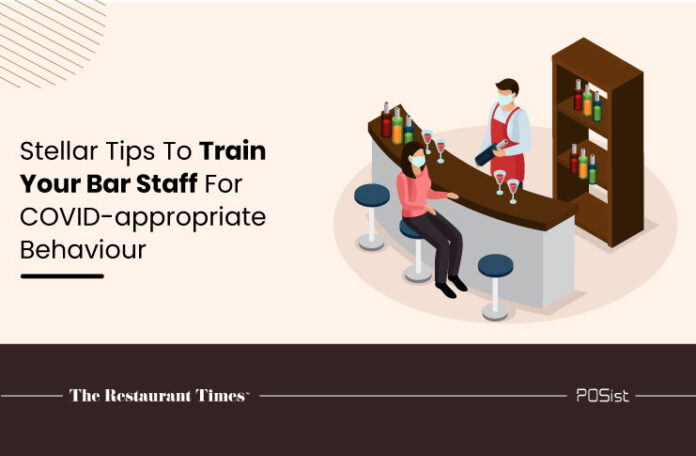The Covid-19 pandemic has transformed conventional practices and standards across industries. The hospitality sector has had to undergo some significant changes in a very short span of time to survive amidst the new normal. After all, the pandemic has changed how people meet and interact socially. Hence, it is now imperative to train your new bar staff to comply with COVID-19 protocols and keep the drinks flowing.
According to the National Restaurant Association, over 110,000 restaurants and bars closed for business in the United States in 2020. The closure of these establishments led to the loss of nearly 2.5 million jobs as compared to pre-pandemic levels. Now that the bars are back to normal, the need to train staff for COVID-appropriate behaviour has increased owing to the safety of customers and premium service quality.
4 Ways To Train Your New Bar Staff For COVID-Appropriate Etiquette
We know the ‘why,’ but establishments are still struggling on ‘how’ to train their new staff for COVID-appropriate behaviour. It is not only crucial that your bar staff adhere to the Covid-19 guidelines set for workplaces, but it is also essential to train them to ensure that your business is not just surviving in the pandemic but thriving.
1. Correct Usage Of Protective Equipment
The first step to guarantee your bar is running smoothly is ensuring staff safety. Give your staff access to suitable protective equipment such as face masks, gloves, and sanitisers, and set up guidelines on their appropriate usage. Here are a few COVID-appropriate SOPs you could implement:
- Places to eat and drink will have customers taking off their masks, so ensure that your staff has their masks on at all times. Face masks help protect against and reduce the risk of transmission of COVID-19.
- Install sanitizing stations and keep a stock of adequate hand washing supplies. Ensure that your staff sanitizes their hands at regular intervals, including before and after serving or interacting with their customers.
- Put up signs near the seating area, at the entrance, and in restrooms that act as a reminder to maintain and promote everyday protective measures. This will assist in keeping your staff and customers safe.
- Educate your staff on the importance of keeping constant tabs on their health. Set guidelines on when to stay home, if they are infected, and when they can come back to work.
2. Using The Hands-free Method
Social distancing, a temporary solution in the wake of the pandemic, is rapidly becoming the norm in most establishments of the hospitality sector. Social distancing measures have highlighted the importance of low to no-contact methods of serving and being served. Training your new bar staff in using the hands-free method will no more be just a means to protect themselves and their customers. Going hands-free is the new normal, and it is here to stay.
Along with protecting the customers and staff, this is also something that customers expect in places they now visit wine and dine.
- Ensure that your establishment has the required setup to start implementing the hands-free method.
- Put up signs and create guidelines on how to operate the new set-up.
- Train your new bar staff to follow the hands-free protocol while using doors, sanitizing and handwashing stations, restrooms, and trash bins so that they can also help customers access these areas.
3. Interacting With Customers
The new Covid-19 guidelines and safety protocols have transformed customer interaction. You must train your new bar staff for effective communication skills to help customers abide by the new guidelines. Protocols can sometimes impede the smooth experience that customers expect from restaurants and bars. More often than not, they will also require a bit of guidance on how to navigate the new setup and ways of functioning.
Some visitors may not be too keen to abide by the Covid-19 rules and guidelines, leading to conflict. Train your staff to help these customers. Be prepared for such situations by enrolling them in Covid-19 training courses and providing them with resources to identify signs of escalation, stay calm in such cases, and assist others.
4. Online Payment & Contactless Ordering
The pandemic has made customers apprehensive about touching the same menu card that has been passed around dozens of times. Digitizing ordering and payments at bars and restaurants has multiple benefits for your staff and customers.
This is the best time to offer your customers contactless WiFi Based ordering options and adopt the Contactless Dining Feature found in the latest POS systems. With this feature, your customers can easily place an order on their smartphones by connecting to the WiFi and accessing a digital menu. The servers confirm the order at the table after a customer places their order and registers their contact number. Customers can also re-order or add new items to their existing order with this feature.
Similarly, customers can scan the QR code at each table and place their order seamlessly, using a QR Code Ordering Dashboard.
Both these features allow a customer to request bills on their devices and make a payment via any digital payment app. The receipt is then auto-generated and sent to the customer’s device.
Keeping an open line of communication where your new staff can suggest, share their concerns, and give feedback will boost their faith and confidence in your establishment. Educate your employees to ensure that protocols are being followed, inform them about the measures the business is taking to prioritize their safety, and train your new bar staff on what will keep them and your customers safe in this new normal.


















